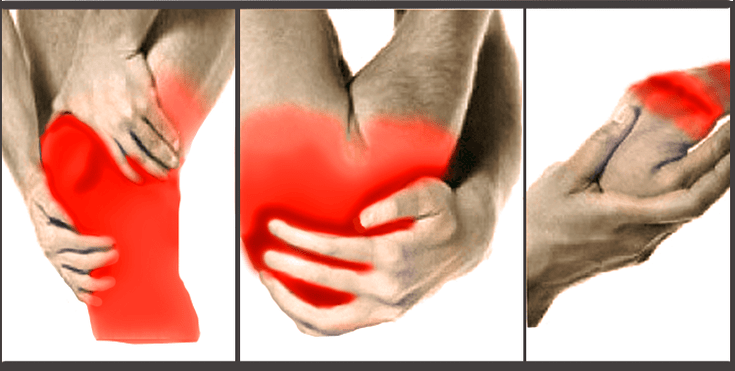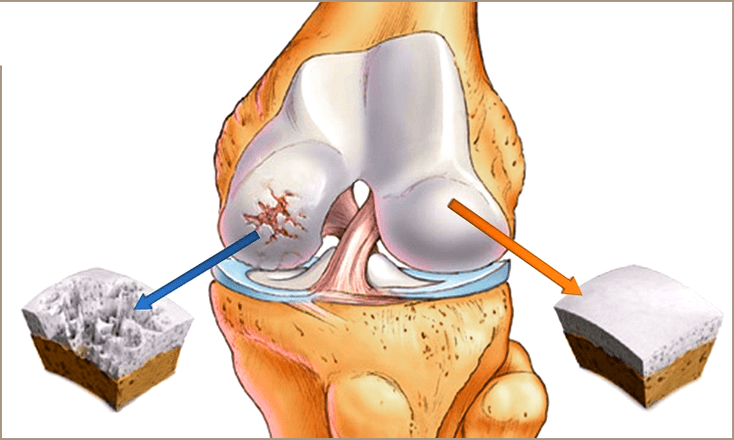What is the difference between arthritis from arthritis, you need to know not only doctors.Often engaged in themselves -Mericjen, people expose themselves to great risk, taking an illness for another.Such a mistake can lead to serious complications, so in the article we fully analyze changes in symptoms, traits of treatment and prevention of pathologies.Knowing the symptoms will help to take the necessary measures in a timely manner.With arthritis or arthritis, all our mobile compounds at the bone joint, cartilage, ie skeletal joints.Often, diseases are confused with one another due to consonant names, but the difference between them is not only in symptoms, but in the causes of the occurrence, the traits of the course, the specifics of therapy.

What is the difference between arthritis and arthrosis: a general concept
In the names there is a common root of "Artro", translated from Greek means a union that undergoes underlying disorders.However, arthritis does not have an inflammatory nature, the base is degenerative processes, ie the coating, and the exact determination of the disease is osteoarthrosis, as bone formations are subject to changes.
Arthrosis is a chronic disease in which the "deletion" of the articular surfaces and capsules occurs, due to which the deformation begins.In advanced cases - complete immobilization of the limbs.Changes affect all complex surfaces - bones, ligaments, meniscus, cartilage, synovial shell, all structures located nearby.
Pathologies are subjected to older people.Moreover, the older, the more the spread of the disease increases.In rare cases, young people can affect young people with hereditary signs or after an injury.According to statistics, about 10% of the population suffers, and the main threshold is observed in people over 65 (85% of all patients).
Arthritis, on the contrary, is an acute disease, which is based on inflammation.Often, the disease is only a symptom of underlying disease (rheumatism), but can continue as a single violation.The neglected stages are transferred to a chronic flow.Unlike arthritis, young people are most often subject to inflammatory damage.It can manifest itself after 40 if a person has suffered a serious cold or infection.The prevalence between the population of the globe is only 2%.
Reason
Due to different etiologies, different causes and factors lead to the appearance of diseases.Moreover, arthritis often occurs against the backdrop of purulent arthritis or rheumatism.
The main factors of arthritis.
- Common trauma and surgical interventions.
- Congenital dysplasia (underdevelopment) of the joints.
- Processes in doostrophic depth.
- Excess weight.
- Old age.
- Inheritance.
- Climate.
With this disease, the joints suffer exclusively, while with arthritis there is a general inflammatory process.It is often associated with kidney, heart and liver damage.
Some types of disease are distinguished:
- rheumatoid;
- reactive;
- infectious;
- gout
Very often, arthritis arises on the background of transferred flu, frequent sore throat.The development of tuberculosis, gonorrhea, dysentery, psoriasis is not excluded.
Arthritis rarely affects single joints, usually a whole group undergoes inflammation, which depends on etiology - with rheumatism, small compounds of hands and feet suffer, with psoriasis - phalanges of fingers.

Symptoms
Despite the similar signs - pain, restriction in motion, deformation, there are a number of symptoms that help distinguish between the name of the disease.
- Pain is a major sign of arthrosis, but it does not happen immediately.Initially, this is a crisis and cracking of the joints, and then joins the pain, which grow as they progress.They usually appear with physical exercises, change of weather, at night (the onset of pain - immediately after waking up and attempts to get out of bed).Arthritis is characterized by persistent pain pain, which can intensify at night as well as in the morning.Often, with inflammation, there is a decrease in unpleasant symptoms during active movements.
- The crystory is a specific sign of arthrosis.It has a special sound - dry and rough, often associated with sharp pain.
- Deformation - with degenerative changes, the joints vary in the later stages, when the adjacent bone surfaces are included in the process.With inflammation, deformation begins at the earliest stages as they grow in size due to swelling.
- Redness, an increase in local temperature - is only characteristic of arthritis, as degenerative diseases continue according to the type of aseptic (unaffected) necrosis.
- Limitation in motion - arthritis often "blocks" the joint when, when moving, a sharp crisis is distributed, followed by a sharp pain and joint block.Arthritis has a tendency for breakfast stiffness, not just in the joints, but throughout the body.
- Overall malace - inflammation, always continues with a change in the condition of the whole organism, there is an increase in body temperature, weakness.
Almost all joints can affect the localization of diseases, however, knee and hip damage is more characteristic of degenerative processes.Arthritis has a tendency to include small joints of the arms and legs in inflammation, often symmetrically.
Important: Do not confuse the pressure of healthy arthrose joints.In the first case, it is absolutely painless and associated with the features of the ligamentous apparatus (excessive mobility, weak ligaments).Then, as with arthrosis, the crunch is associated with severe pain and restrictions on the move.
Troubleshooting
An important diagnostic criterion is a general blood test.Inflammation of the joints always gives an increase in ESR (more than 25 mm/h), and in the case of infectious arthritis, leukocytes are still.For arthrosis, blood change is not characteristic.
By the way, there is a particular protein, belongs to the class of immunoglobulins, responds to damage from each factor to its own cells-a rheumatoid factor that allows you to determine the presence of rheumatoid arthritis.It is also determined reactive protein C, which is a sign of inflammation.Gout is characterized by an increase in uric acid in the blood, urine.
For both diseases, first of all, it is necessary to pass not just a blood test, always an X -Ray of the joint.With arthrosis, there is a narrowing of the gap between joints, osteophytes (bone growth), deformities and osteoporosis.It is possible to assign CT, MRI to clarify changes in soft tissue and bone structures.
Arthrosis is also characterized by narrowing of the periarticular osteoporosis, however, they occur in the early stages (then, as with degeneration, such changes only begin in stages 3 and 4).If the process has an infectious character, the sequencing often formed - areas of necrosis surrounded by a healthy tissue.In a chronic course, displacements, subluxation of hanging structures are observed.
It is advisable to do an ultrasound in order to determine the presence of a fluid or pus in the common (most characteristic arthritis) bag as well as diagnostic punctuation - allows you to identify the pathogen and nature of the effusion.
Be sure to describe general examinations - ECG, urine analysis, blood biochemistry, to learn about their possible involvement in inflammation.
Treatment
Important: The most dangerous for both diseases is itself -Memication.Without an accurate diagnosis, this approach to its health only exacerbates the situation, leading to a significant destruction of joints, heart damage and kidneys.
How arthritis differs from arthritis to therapy.The basis for the former is the stop of destruction, degeneration of cartilage tissue and in the treatment of arthritis, the main role is dedicated to the removal of inflammation and blocking of the infectious process.
Access to eliminate manifestations of pathologies should include not only medication but also a change in lifestyle - healthy eating, weight loss, control of physical activity.
Medication therapy includes non -steroidal anti -inflammatory (indispensable for both diseases), muscle relaxants and chondroprotectors (most often with arthrosis).
The treatment of arthritis often requires the introduction of glucocorticosteroids into the intersection space, the use of antibiotic therapy and the function of plasma (blood purification) to eliminate autoagresia (body response to its cells, for a foreign agent).In severe cases, the introduction of stem cells is introduced - relieves inflammation, reduces sensitivity to infection, improves metabolism and tissue nutrition.
Important: with arthritis, heat compresses and ointments cannot be applied, they will only increase the spread of infection and inflammation, especially with the purulent course of the disease.
All physiotherapy is prescribed only after you have relieved acute pain and inflammation.
Despite all the innovations and rapid development of medicine, arthritis is an incurable disease.It is simply not possible to adjust the degenerative changes that have begun.Arthritis is well subjected to therapy, especially when looking for a doctor.
Tab
| Distinction |
Arthritis |
arthrosis |
| Age | Unlimited | Mainly after 45 |
| The development of pathology | suddenly | Gradually |
| Reason | Infection | Degenerative (age, menopause, injuries, genetics) |
| COURSE | Acute, with moments of forgiveness | Chronic, with periods of irritation |
| wipe off | From small to large ones.Symmetry is characteristic. Includes ligaments, severe inflammation meniscus, swelling. Internal organs suffer. |
Most often big single.Pharalx risk of fingers.It spreads to the cartilage, meniscus, ligaments, but without edema. |
| Deformity | External growth due to swelling. | In the late stages, the formation of necrotic fragments, then destroyed |
| Signs | In the acute period - temperature mistreatment, a sharp crisis with pain and jam, a swollen hot surface, a pronounced difficulty in motion. | Is a dull pain.Weighing, stiffness after charging of withdrawals. |
| Troubleshooting | General blood test, urine.Biochemical - blood. Evidence X -Ray is a sharp change of structures at the onset of the disease. |
Minor changes in the blood.X -Ray indicates pathology in later stages. |
| Treatment | Anti -inflammatory, soothing soothing.It recovers with timely treatment. | Anesthesia, ointments, compresses, physiotherapy, exercise therapy, chondroprotectors. With irritation - anti -inflammatory. |
What is worse than arthritis or arthritis cannot be said for sure, but inflammation is well blocked by medicines, which cannot be said for degenerative processes.Often, both diseases should be treated throughout your life, with the possibility of reaching long -term remission.Arthrosis often needs operational correction to restore union function and remove the restriction in motion.
Arthritis can be associated with the development of heart defects (rheumatoid damage to the valves) and diseases of the organs and other systems, because inflammation of the joints is only the "tip of the iceberg".Successful treatment begins precisely with the definition of etiology.
It is important to prevent the late stages from destroying bone tissue and chronic inflammatory process.A specialist's timely appeal will help teach his diagnosis accurately, as well as receive the necessary assistance in treatment and rehabilitation.Now you know what the differences are between arthritis and arthritis.



















